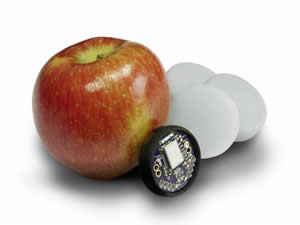Simple to program and debug open source BLE beacon
It is the last week on Kickstarter for delivery in December (campaign ends Friday 5th August at 8pm GMT), and the $30 Puck.js BLE beacon has all the required programing and debug software tools built-in and runs from a single Nordic Semiconductor nRF52832 BLE SoC with built-in ARM Cortex M4F processor.
 The Puck.js is said to be so simple to program almost anyone can do it wirelessly from a website using a graphical editor or easy-to-learn JavaScript instead of C or C++ traditionally used by BLE beacon developers.
The Puck.js is said to be so simple to program almost anyone can do it wirelessly from a website using a graphical editor or easy-to-learn JavaScript instead of C or C++ traditionally used by BLE beacon developers.
Gordon Williams, UK-based Puck.js creator, commented: “Most manufacturers conveniently gloss over the difficulties of programming their hardware, and other beacons are provided without software or left crippled by their boring factory-installed firmware. Puck.js is different. It comes with our Open Source JavaScript interpreter ‘Espruino’ pre-installed, which makes it incredibly easy-to-use and means you can get started in just seconds, without any prior programming experience.”
The intentionally hacker-friendly Puck.js is open source, supports both the iBeacon and Eddystone beacon formats, and will be supplied with firmware updates for the forthcoming Bluetooth v5.0 specification that will quadruple the range and double the speed of Bluetooth v4.2. Puck.js has a circular 35mm diameter form-factor that is 10mm thick, with a silicone rubber cover and plastic base. It is powered from a CR2032 coin cell battery and includes a magnetometer (digital compass), user-assignable tactile button and four (Red, Green, Blue and Infrared) LEDs.
Thanks to the Nordic Semiconductor nRF52832 SoC, the Puck.js benefits from an extremely powerful ARM Cortex-M4F processor, 64MHz clock speed, an extremely generous 64kB of RAM and 512kB of Flash, built-in NFC, OTA firmware updates, 12-bit ADC, timers, SPI, I2C and serial interfaces that can be used on any available pins, plus a temperature sensor.
Williams says that in summary this means the Puck.js can measure rotation (e.g. using the Puck as a control knob), light, temperature, magnetic fields (e.g. magnets used on doors to detect opening and closing or water level via a magnet on a float), can control Infrared devices and produce any color light.”
JavaScript is probably the most popular programming language at the moment and the majority of web developers, makers and students at school wouldn’t usually have used C or C++. So what I aimed to do with Puck.js was lower the barrier-to-entry and make development easier and more fun – allowing a whole bunch of people to use BLE beacon and IoT technologies that may otherwise be restricted to professional embedded developers,” added Williams.
Williams said Puck.js is like a development kit that’s also a finished product: “You insert a battery, put the case on, and it’s a ready-to-go BLE beacon straight-out-the-box with no wires of software required. At the same time it’s very easy to add new functions and features for home automation projects, IoT prototyping or education purposes.”

Comments are closed, but trackbacks and pingbacks are open.